Text
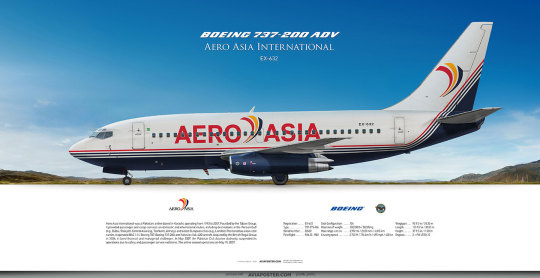
Boeing 737-200 Aero Asia International
Registration: EX-632 Type: 737-2T5 Adv Engines: 2 × PW JT8D-15 Serial Number: 22632 First flight: Feb 22, 1982
Aero Asia International was created to make air travel accessible to Pakistanis and meet the growing demand for regional connectivity. The airline positioned itself as a budget carrier, promising affordable fares without compromising service quality. Its operational hub in Karachi, Pakistan’s economic center, provided strategic access to both domestic and international markets.
By the late 1990s, Aero Asia had solidified its presence in the regional aviation market. Its low-cost model resonated with price-sensitive travelers. Cargo services also generated a steady client base, transporting goods to trade hubs in the Middle East and Central Asia.
Despite early successes, Aero Asia faced significant obstacles. Fluctuating fuel prices, maintenance expenses for an aging fleet, strained Aero Asia’s finances. Additionally, Pakistan’s aviation sector was subject to stringent oversight, and the airline struggled to consistently meet the safety and service standards of the Pakistan Civil Aviation Authority (PCAA).
The final chapter of Aero Asia’s story unfolded in 2007. The PCAA, citing repeated violations of safety standards and passenger service quality, suspended the airline’s Air Operator Certificate in May 2007. On May 19, 2007, Aero Asia International ceased operations, concluding its 14-year journey.
Airliner Profile Scenic Posters for Aviators aviaposter.com
7 notes
·
View notes
Text
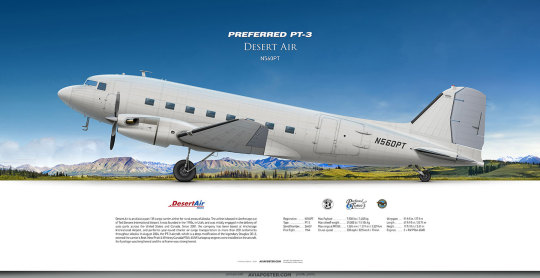
Preferred PT-3 Desert Air
Registration: N560PT Type: PT-3 Engines: 2 × PW PT6A-65AR Serial Number: 26439 First flight: 1944
The Preferred PT-3TP (N560PT), operated by Desert Air Alaska, is a unique modification of the legendary Douglas C-47 (the military version of the DC-3), adapted for the harsh conditions of Alaska. Built in 1944 and modernized in 1998, this rare aircraft combines the time-tested design of the classic airframe with modern technology. This makes it an ideal choice for flights to remote regions where reliability is paramount. Equipped with Pratt & Whitney Canada PT6A-65AR turboprop engines, the PT-3TP retains the simplicity of the original C-47 while offering improved fuel efficiency and simplified maintenance. These qualities are critical for operations in the resource-scarce environment of the Last Frontier.
Desert Air Alaska employs the PT-3TP for cargo deliveries and charter flights to hard-to-reach corners of the state, where the nearest hangar may be hundreds of miles away. This model stands out for its ability to operate on short, unpaved airstrips, and the expertise of its pilots ensures that this rare aircraft remains an effective tool in Desert Air’s mission to connect Alaska’s isolated regions with the outside world.
I wrote about Desert Air and their Douglas DC-3 back in late 2023. This past spring, I posted about the Basler BT-67, another deep modification of the DC-3 veteran, also operated by this company. Today’s featured aircraft joined Desert Air’s fleet late last year and has already settled into its new environment. How long will Desert Air Alaska keep their DC-3s and their modernized variants in the sky? Judging by their meticulous approach, quite a while longer. Parts for these planes are still available, and there’s always work for them. I’m confident we’ll see them soaring for years to come.
Airliner Profile Scenic Posters for Aviators aviaposter.com
3 notes
·
View notes
Text

Bombardier Learjet 45 Medway Air Ambulance
Registration: N570MP Type: Learjet 45 Engines: 2 × TFE731-20AR-1B Serial Number: 45-171 First flight: 2001
Medway Air Ambulance is a U.S. company based in Lawrenceville, Georgia, specializing in medical air transport. Founded in 2000, it’s a top player in North America’s air ambulance scene. They fly patients worldwide, providing onboard medical care for adults, kids, and newborns.
Over the years, Medway has expanded its fleet and upgraded its medical gear. It’s built a solid rep as a trusted partner for hospitals, insurance companies, and workers’ comp programs.
Medway’s fleet includes eight Learjet planes, customized for medical missions. Each is loaded with cutting-edge equipment like ventilators, defibrillators, vital signs monitors, and other critical care tools. This setup allows complex procedures, including life support, ECMO, or oxygen therapy, mid-flight, even for critically ill patients.
With strict adherence to international standards, a pro crew, and a modern fleet, Medway delivers safe, efficient patient transport globally. Over 20 years of experience and multiple accreditations cement its status as a leader in air ambulance services.
Airliner Profile Scenic Posters for Aviators aviaposter.com
5 notes
·
View notes
Text
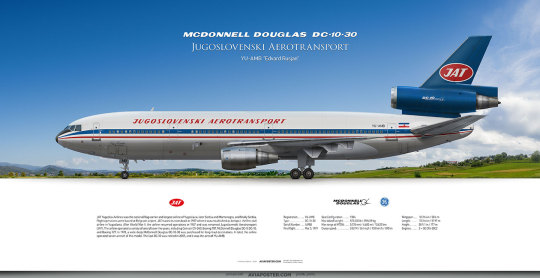
McDonnell Douglas DC-10-30 JAT Jugoslovenski Aerotransport
Registration: YU-AMB Named: Edvard Rusjan Type: DC-10-30 Engines: 3 × GE CF6-50C2 Serial Number: 46988 First flight: Mar 5, 1979
The first DC-10 acquired by JAT, the national carrier of the Socialist Federal Republic of Yugoslavia, landed in Belgrade on December 12, 1979. This moment was a milestone for both the airline and Yugoslavia as a whole. Named after the renowned scientist Nikola Tesla, the aircraft was greeted with a ceremonial event. Instead of the traditional champagne, water from Tesla’s native village of Smiljan was used to “christen” the plane, emphasizing national pride and the symbolism of the occasion. This DC-10, registered as YU-AMA, became the first wide-body aircraft in JAT’s fleet, opening a new chapter in its history. The second DC-10 (YU-AMB) was named after Edvard Rusjan, a Slovenian aviation pioneer whose early 20th-century flights marked a significant milestone in Yugoslav aviation history.
The DC-10 enabled JAT to significantly expand its flight network. The aircraft was used on key long-haul routes to destinations such as New York, Chicago, Singapore, Beirut, and Cairo. Configured for 270 passengers in a two-class layout, the DC-10 offered comfort and capacity, making it ideal for long flights. Its operation bolstered JAT’s competitiveness among leading global carriers.
After the prosperous 1980s, the 1990s brought significant challenges. The breakup of Yugoslavia and subsequent wars led to economic difficulties and international sanctions. In 1992, a UN embargo halted JAT’s international flights, limiting its operations to domestic routes between Belgrade, Podgorica, Tivat, and other cities. The DC-10, designed for long-haul flights, became underutilized, and its operations were temporarily suspended.
Following the partial lifting of sanctions in 1994, JAT resumed international flights, and the DC-10 once again became a vital part of its fleet. However, financial difficulties and the aging of the aircraft, coupled with the emergence of more fuel-efficient models like the Boeing 767 and Airbus A330, led to the gradual phasing out of the DC-10. By the early 2000s, JAT began replacing the DC-10 with more modern aircraft, and the final flight of this type in JAT’s fleet took place in 2004. The planes were either sold or converted for cargo operations by other carriers.
Airliner Profile Scenic Posters for Aviators aviaposter.com
7 notes
·
View notes
Text
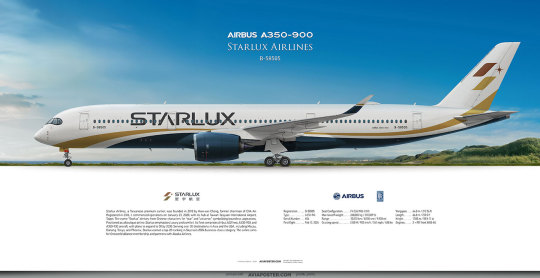
Airbus A350-900 Starlux Airlines
Registration: B-58505 Type: A350-941 Engines: 2 × RR Trent XWB-84 Serial Number: 656 First flight: Feb 13, 2024
In the competitive landscape of global aviation, the emergence of a new carrier often signals ambition and innovation. Starlux Airlines, a Taiwanese premium-class airline, embodies this approach. Founded in 2018 by Chang Kuo-wei, former chairman of EVA Air and son of Evergreen Group founder Chang Yung-fa, Starlux Airlines was conceived as a boutique airline with the goal of redefining luxury air travel. Registered with Taiwan’s Ministry of Economic Affairs in November 2016, Starlux became the first significant new player in Taiwan’s aviation market in three decades, challenging the duopoly of China Airlines and EVA Air.
Starlux Airlines operated its inaugural flight from Taipei to Macau on January 23, 2020, having received its air operator’s certificate on December 10, 2019, and opened reservations on December 16. However, the launch coincided with the onset of the COVID-19 pandemic, which paralyzed global aviation. Within months, Starlux suspended most flights, maintaining only a limited schedule to Da Nang. By March 2020, operations were fully halted until June 2, when three weekly flights to Macau resumed. Plans for routes to Naha and Cebu were postponed, with Naha services never launching due to ongoing uncertainties. Despite these challenges, Starlux demonstrated resilience, leveraging its new fleet and premium positioning to navigate the crisis.
With the recovery of the aviation industry, Starlux pursued aggressive expansion. In August 2022, the airline announced its entry into the North American market, launching Taipei–Los Angeles flights on April 26, 2023, followed by routes to San Francisco and Seattle. In September 2022, Starlux unveiled a strategy to connect Southeast Asian cities to the U.S. via Taipei. As of March 2025, the airline serves over 20 destinations, including Tokyo, Osaka, Kuala Lumpur, and Ontario, California, with plans to launch European routes by 2026.
In October 2024, Starlux received the Five Star Major Airline Award from APEX, reflecting passenger approval. Skytrax ranked Starlux’s business class among the world’s top 20 in 2024, a remarkable achievement for an airline less than five years old. Its focus on luxury, including gourmet dining and personalized amenities, distinguishes Starlux in a competitive market.
Poster for Aviators aviaposter.com
4 notes
·
View notes
Text
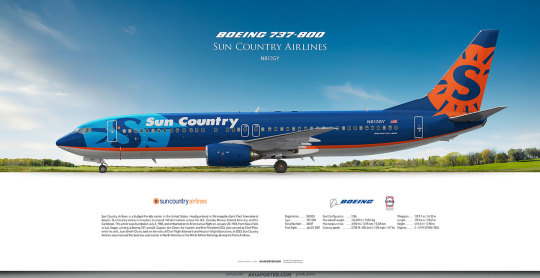
Boeing 737-800 Sun Country Airlines
Registration: N813SY Type: 737-8Q8 Engines: 2 × CFMI CFM56-7B26 Serial Number: 28237 First flight: Jan 29, 2001
Sun Country Airlines was established in July 1982 by a group of former Braniff International Airways employees, which ceased operations in May of that year. Among its founders were pilots and flight attendants who, after losing their jobs following Braniff’s collapse, aimed to create a new airline focused on leisure charter services. The initiative was led by Ken Sundmark, who, alongside Bob Daniels, co-founder of Mainline Travel Inc., proposed the idea of a charter carrier. Captain Jim Olsen played a key role in the founding, becoming the first president and CEO of the airline, as well as its chief pilot. His wife, Joan Smith-Olsen, took on the roles of senior flight attendant and head of flight operations, significantly contributing to the development of the company’s operational structure. Sun Country’s first flight took place on January 20, 1983, from Sioux Falls, South Dakota, to Las Vegas, Nevada, using a leased Boeing 727-200. The initial workforce consisted of just 36 employees: 16 pilots, 16 flight attendants, three mechanics, and one office worker.
In the 1990s, Sun Country began transitioning from solely charter services to scheduled flights, launching regular services from Minneapolis to major U.S. cities in 1995. In 1999, the airline was acquired by a Minnesota-based investment group led by William La Macchia Sr., after which it officially became a scheduled carrier, competing with Northwest Airlines. This period saw the expansion of its route network to include international destinations in Mexico and the Caribbean.
As of March 2025, Sun Country’s fleet comprised 46 passenger and 15 cargo Boeing 737-800 aircraft, serving approximately 140 destinations across the U.S., Canada, Mexico, Central America, and the Caribbean. Sun Country Airlines occupies a unique niche in the U.S. aviation industry, balancing three business segments: scheduled passenger services (70% of revenue), charter flights (20%), and cargo operations (10%). This hybrid model enables efficient resource allocation, crew management, and aircraft utilization across segments, minimizing seasonal revenue fluctuations.
Poster for Aviators aviaposter.com
6 notes
·
View notes
Text

Bombardier CRJ900 Adria Airways
Registration: S5-AAK Type: 900LR (CL-600-2D24) Engines: 2 × GE CF34-8C5 Serial Number: 15128 First flight: May 2007
Since 2007, Bombardier has been producing the upgraded CRJ900 NextGen, which featured modernized cockpit equipment, a 5.5% improvement in fuel efficiency compared to the base model, and an enhanced cabin interior. Adria Airways operated this particular modification, primarily the CRJ900LR (Long Range) variant, capable of flying routes up to 3,300 km. In 2018, the airline’s fleet included nine aircraft of this model, making up a significant portion of its fleet alongside Airbus A319s, Bombardier CRJ700ERs, and CRJ200LRs. The “900’s” cabin layout offered two classes of service—business and economy—with a total capacity of 86–90 passengers. This configuration met the airline’s needs for routes from Ljubljana to cities like Frankfurt, Zurich, and Istanbul.
Adria Airways’ main hub was Ljubljana Jože Pučnik Airport, from which it operated most of its flights, including 170 weekly scheduled departures to 24 European destinations. The CRJ900 played a central role in this network, serving both short routes (e.g., Ljubljana–Vienna, Ljubljana–Skopje) and longer ones, such as flights to Moscow (Sheremetyevo Airport, Terminal F). These aircraft were also used for flights from secondary hubs in Pristina and Tirana, highlighting their versatility.
Adria Airways’ route network was designed to integrate with Star Alliance partners like Lufthansa, Austrian Airlines, and Swiss International Air Lines, enabling seamless connections through major European hubs. The CRJ900 was ideal for this model, offering high-frequency flights on routes with limited demand.
On charter routes, which formed a key part of the airline’s business, Adria frequently deployed the “900s.” These aircraft were used for seasonal flights to Mediterranean and Red Sea resorts, allowing the airline to flexibly adapt to changing demand. Passengers noted the cleanliness of the cabins and quality onboard service, including meals tailored to flight duration and the option to order special menus.
The operation of Bombardier CRJ900 aircraft by Adria Airways serves as an example of how regional jets can be effectively integrated into a mid-sized airline’s route network, efficiently serving routes with moderate demand.
Poster for Aviators aviaposter.com
7 notes
·
View notes
Text
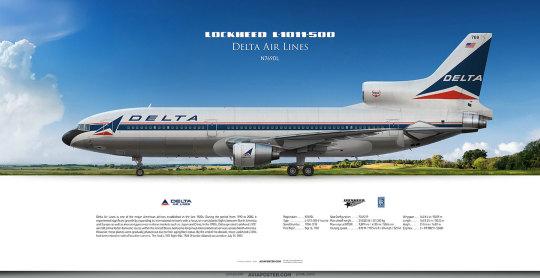
Lockheed L-1011-500 Delta Air Lines
Registration: N769DL Type: L-1011-385-3 Tristar 500 Engines: 3 × RR RB211-524B4 Serial Number: 193H-1218 First flight: Sep 16, 1981
By the early 1980s, Delta operated the world’s largest L-1011 fleet, encompassing variants L-1011-1, -100, -200, -250, and -500. At its peak, the airline’s fleet included up to 56 TriStar aircraft, serving 79 domestic and international destinations, including Delta’s first transatlantic and transpacific routes. The L-1011 became the cornerstone of the “Wide Ride Fleet” concept, which emphasized cabin comfort, spaciousness, and a quieter, smoother flight compared to competitors.
The L-1011 was deployed on key routes, such as Atlanta–London, as well as domestic flights to major cities like Los Angeles, Dallas, and Miami. Its range (up to 4,000 nautical miles for the L-1011-500) enabled Delta to meet the growing demand for air travel between North America and Europe.
Poster for Aviators aviaposter.com
9 notes
·
View notes
Text

Sukhoi Superjet 100-95 Azimuth Airlines
Registration: RA-89179 Named: Tobol Type: 100-95B Engines: 2 × SaM146 Serial Number: 95182 First flight: Feb 6, 2019
In the spring of 2017, a new company emerged in Russia’s aviation sector—Azimuth Airlines. Based in the south of the country, this carrier set an ambitious goal at the outset: to connect regions often overshadowed by larger airlines. Azimuth established its primary bases at Platov Airport (Rostov-on-Don) and Pashkovsky Airport (Krasnodar), with an additional hub in Mineralnye Vody. These cities served as the starting points for a route network that spans southern and central Russia, as well as select international destinations.
From the beginning, Azimuth focused on routes linking smaller cities with major hubs. By 2025, the airline was serving 162 destinations, underscoring its commitment to making air travel more accessible. Domestically, its aircraft fly to cities such as Kazan, Yekaterinburg, Samara, Volgograd, and over forty other routes, fostering economic and social ties across Russia’s vast expanse. Internationally, Azimuth operates flights to Tbilisi, Tel Aviv, Almaty, and about a dozen other destinations. A significant milestone came in 2020 with the launch of regular flights to Crimea, reflecting demand for this destination.
A distinctive feature of Azimuth is its fleet, composed entirely of Sukhoi Superjet 100 aircraft. By 2025, the airline operated 19 of these jets, a choice driven by both practicality and support for domestic aviation manufacturing. The Sukhoi Superjet 100 is well-suited for the regional routes that form the backbone of Azimuth’s network. Each aircraft is named after a Russian river, symbolizing a connection to the country’s geography and history. For example, aircraft RA-89179 is named after the Siberian river Tobol, evoking the diversity of Russia’s landscapes. Thus, Azimuth successfully demonstrates how a regional carrier helps bridge distances – both geographic and cultural.
Poster for Aviators aviaposter.com
3 notes
·
View notes
Text

Boeing 787-8 TUI Airways
Registration: G-TUII Named: Mrs Patmore Type: 787-8 Engines: 2 × GE GEnx-1B64 Serial Number: 37230 First flight: May 1, 2015
TUI Airways, founded in 1962, is the world’s largest charter airline and a key component of the international tourism conglomerate TUI Group. The company’s history began with the establishment of Britannia Airways, which evolved over decades, adapting to changes in the aviation and tourism industries. In 2008, the modern TUI Airways was formed through the merger of two British airlines, Thomsonfly and First Choice Airways, combining their route networks and operational resources. This move strengthened the company’s position in the charter travel market, offering flights from 17 bases in the UK and Ireland to over 70 destinations in Europe, Africa, Asia, and North America.
TUI Airways’ primary focus is serving tourist destinations, including popular resorts in the Mediterranean, the Caribbean, and long-haul routes to Asia and North America. The airline caters primarily to TUI Group’s package holiday customers but also operates scheduled flights, providing flexibility and accessibility to a broader audience. Its flight network covers regions such as the Canary Islands, Turkey, Egypt, Thailand, Mexico, and the USA, making TUI Airways a vital player in international tourism.
As of May 2025, TUI Airways’ fleet consists of 69 aircraft, with a significant portion comprising Boeing 737-800 and Boeing 737 MAX 8, primarily used for short- and medium-haul routes. However, the Boeing 787 Dreamliner stands out as a cornerstone of TUI Airways’ long-haul strategy.
The Boeing 787 Dreamliner, available in two variants (787-8 and 787-9), accounts for 13 aircraft in the company’s fleet. TUI Airways was the first European airline to order this aircraft in 2005. Deliveries began eight years later, with the first commercial flight on a Boeing 787-8 taking place on June 21, 2013, from London to Menorca. These aircraft feature advanced technologies that enhance passenger comfort through improved cabin humidity, lower noise levels, and an enhanced lighting system. TUI Airways deploys the Boeing 787 on routes to Asia, North America, and the Caribbean, offering a high level of service on long-haul flights. The cabin configuration includes both economy and premium classes, catering to the needs of various traveler categories.
Poster for Aviators aviaposter.com
6 notes
·
View notes
Text
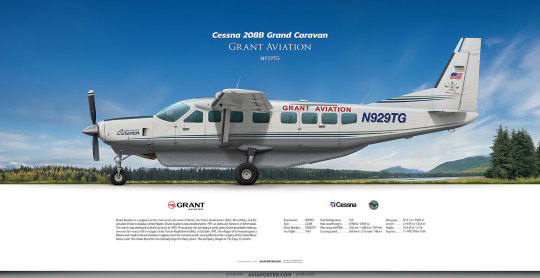
Cessna 208B Grand Caravan Grant Aviation
Registration: N929TG Type: C208B Engines: 1 × PWC PT6A-114A Serial Number: 208B0371 First flight: 1993
Grant Aviation’s story began in 1971 in the small village of Emmonak, nestled in the Yukon-Kuskokwim Delta. Originally established as Delta Air Services, the company initially focused on providing critical aviation services to Alaska’s remote communities, where road infrastructure is virtually nonexistent. In its early years, the airline played a pivotal role in medical evacuations (medevac), responding swiftly to urgent calls from villages to transport patients to medical facilities, often in the dead of night. This dedication to saving lives earned the company profound respect, symbolized in 1994 when the residents of Emmonak presented a totemic owl mask as a gesture of gratitude. This mask, a cultural emblem of Alaska’s Native peoples, later became the airline’s logo, reflecting its deep connection to the communities it serves.
In 1993, the airline rebranded as Grant Aviation, marking a new phase in its development. Today, with its headquarters in Anchorage and operational bases in Bethel, Cold Bay, Dillingham, Dutch Harbor/Unalaska, Emmonak, Kenai, and King Salmon, Grant Aviation has become a key regional carrier, serving Alaska’s diverse communities.
Grant Aviation operates a fleet of over 25 small propeller-driven aircraft, specifically adapted to Alaska’s challenging terrain and unpredictable weather. The fleet includes Cessna 207, Cessna 208 Caravan and 208B Grand Caravan, Piper PA-31-350 Navajo, GippsAero GA8 Airvan, and Beech King Air 200 models, with a total capacity of approximately 250 passengers at a time. These aircraft are ideally suited for short regional flights.
The airline’s operations encompass scheduled flights, charter services, and cargo transport, with a particular emphasis on the Yukon-Kuskokwim Delta, where it is one of the few carriers alongside Yute Commuter Service and Ryan Air Services. Grant Aviation connects eight key destinations, including Anchorage, Bethel, Cold Bay, Dillingham, Emmonak, Kenai, King Salmon, and Unalaska/Dutch Harbor. Its services are indispensable for residents who rely on aviation for access to healthcare, education, and economic opportunities. Additionally, Grant Aviation partners with LifeMed Alaska to provide air ambulance services, continuing its legacy of supporting emergency medical care in the Yukon-Kuskokwim Delta.
Poster for Aviators aviaposter.com
4 notes
·
View notes
Text

ATR 72-600 Caribbean Airlines
Registration: 9Y-TTI Type: 72-600 (-212A) Engines: 2 × PWC PW127M Serial Number: 1318 First flight: Mar 19, 2016
Caribbean Airlines, the flag carrier of Trinidad and Tobago and a leading airline in the Caribbean, has long been a vital connector of the region’s islands.
When Caribbean Airlines took to the skies on January 1, 2007, as the successor to BWIA West Indies Airways, it inherited a mission to unite the diverse islands of the Caribbean. While Boeing 737-800s served longer routes, the airline needed a reliable and cost-effective aircraft for short inter-island flights. Initially, this role was filled by the De Havilland Canada Dash 8-300, but by the late 2000s, Caribbean Airlines transitioned to the ATR 72-500 to expand its regional operations.
By the early 2020s, Caribbean Airlines recognized the need to modernize its regional fleet to align with global aviation trends. The ATR 72-500s, though reliable, were aging, and the airline sought a successor to enhance efficiency and elevate onboard services. The answer was the ATR 72-600, the latest model in ATR’s turboprop family. By 2024, the ATR 72-600 had fully replaced the older “-500” models, becoming the cornerstone of the airline’s regional operations. These aircraft now serve routes to destinations such as Barbados, Antigua, and Guyana, ensuring seamless connectivity across the Caribbean.
In 2020, Caribbean Airlines underwent a transformative rebranding, marking its first major visual overhaul since its founding. At the heart of this was a new livery that captured the vibrancy of the Caribbean while refreshing the airline’s image. The ATR 72-600, registered as 9Y-TTI, was the first aircraft to debut this livery.
From the introduction of the ATR 72-500 in the late 2000s to the modern ATR 72-600 fleet, these turboprop aircraft have played a vital role in connecting the region’s islands and strengthening economic and cultural ties. As Caribbean Airlines’ popularity continues to grow, the ATR 72-600 remains a steadfast element, carrying the warmth of the islands to every destination it serves.
Poster for Aviators aviaposter.com
4 notes
·
View notes
Text
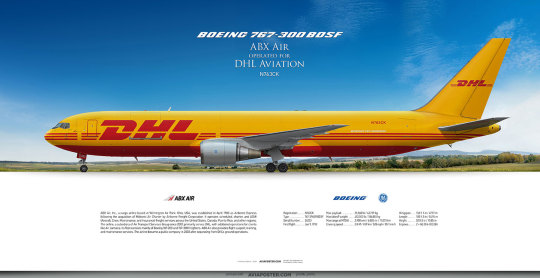
Boeing 767-300 BDSF ABX Air operated for DHL Aviation
Registration: N763CK Type: 767-3P6ER BDSF Engines: 2 × GE CF6-80C2B4 Serial Number: 26233 First flight: Jun 9, 1993
ABX Air, Inc. is an American cargo airline headquartered at Wilmington Air Park, near Wilmington, Ohio. It has established itself as a notable participant in the cargo aviation market, serving both domestic and international routes.
ABX Air was founded in 1980 under the name Airborne Express, following the acquisition of Midwest Air Charter’s cargo division by Airborne Freight. Commercial operations commenced on April 17 of that year. In 2003, after Airborne Freight merged with DHL, the cargo airline operations were spun off into a separate entity named ABX Air.
ABX Air specializes in cargo transportation, offering a wide range of services, including scheduled and charter flights, as well as overnight express deliveries. A key focus is providing services for DHL, which remains the airline’s primary customer. Most of ABX Air’s aircraft are painted in DHL’s red-and-yellow livery, highlighting their close partnership.
ABX Air remains a significant player in the cargo aviation market due to its specialization and strategic partnerships. Despite challenges associated with reliance on major clients like DHL, the airline demonstrates resilience, expanding its international reach and developing supplementary services. Its history, from its founding in 1980 to the present day, reflects its ability to adapt to the dynamic conditions of the logistics industry.
Poster for Aviators aviaposter.com
7 notes
·
View notes
Text

Boeing 787-9 Etihad Airways
Registration: A6-BNE Type: 787-9 Engines: 2 × GE GEnx-1B74/75 Serial Number: 39671 First flight: Aug 26, 2023
Etihad Airways was founded in July 2003 by decree of Sheikh Khalifa bin Zayed Al Nahyan, the ruler of Abu Dhabi. The name “Etihad,” meaning “Union” in Arabic, reflects its goal of uniting people through travel. The first flight on November 5, 2003, from Abu Dhabi to Beirut marked the start of a journey that, over two decades, has turned the airline into an industry leader. By 2008, Etihad was carrying 6 million passengers annually, and today its network spans over 90 destinations.
Unlike its neighbor Emirates, Etihad has focused not just on scale but on innovation. In 2007, the airline opened its headquarters in Khalifa City, investing $50 million in a state-of-the-art complex with a pilot training center. In 2014, Etihad unveiled “The Residence,” a three-room luxury suite on its Airbus A380, which became a sensation in the aviation world. The journey hasn’t been without turbulence: in the 2010s, losses from investments in Alitalia and Air Berlin forced a strategic rethink. Yet, by 2025, Etihad has returned to positive growth, focusing on steady development and fleet modernization.
The Boeing 787-9 and 787-10 Dreamliner are the most numerous aircraft in Etihad’s fleet, with 43 currently in service and more on the way. Their large windows with electrochromic dimming and optimized cabin pressure make flights to Sydney, Tokyo, or Frankfurt less fatiguing.
Etihad is actively modernizing its fleet, aiming to expand to 150 aircraft by 2030. The airline expects delivery of 10 more A321neos, three A350-1000s, and four additional Dreamliners. As for the Boeing 777, after contract restructuring, Etihad has an option to purchase 777X aircraft but could also opt for more 787s. The 777X is not part of their five-year fleet expansion plan.
Poster for Aviators aviaposter.com
9 notes
·
View notes
Text



Boeing 787-8 United Airlines
Registration: N45905 Type: 787-8 Engines: 2 × GE GEnx-1B70 Serial Number: 34825 First flight: Nov 21, 2012
Boeing 787-9 United Airlines
Registration: N26970 Type: 787-9 Engines: 2 × GE GEnx-1B76A Serial Number: 60146 First flight: Jul 27, 2017
Boeing 787-10 United Airlines
Registration: N17015 Type: 787-10 Engines: 2 × GE GEnx-1B76 Serial Number: 66984 First flight: Dec 7, 2021
United Airlines is one of the largest air carriers in the United States, operating a fleet of over 1,000 aircraft and maintaining hubs worldwide. Its route network spans six continents with numerous destinations. In the 2010s, the airline began actively deploying the Boeing 787 Dreamliner family, encompassing all three variants, to serve long-haul flights.
United received its first Boeing 787-8 in 2012, becoming one of the first U.S. airlines to introduce this model. The 787-8 features a three-class cabin configuration, accommodating 243 passengers. These aircraft are primarily deployed on international routes, including flights from the U.S. to Asia (e.g., Tokyo, Shanghai), Europe (London, Frankfurt), and South America. As of 2025, United operates 12 787-8 aircraft, making it one of the largest operators of this variant in the U.S. The model has replaced the aging Boeing 767-300 on select routes due to its extended range of up to 15,700 km.
The next model in the Dreamliner family, the Boeing 787-9, joined United’s fleet in 2014. This elongated variant, with a cabin capacity of 257 passengers, offers a range of up to 16,300 km. As of February 2025, United operates 44 787-9 aircraft. The model is utilized on ultra-long-haul routes, such as Chicago–Singapore and Houston–Sydney, as well as high-demand transatlantic flights (e.g., Washington–Paris). The 787-9 has been instrumental in expanding United’s route network, including new nonstop services.
The longest Dreamliner variant, the Boeing 787-10, entered United’s fleet in 2018, with a range of approximately 12,000 km. Configured with 318 seats across three classes, United operates 21 of these aircraft, deploying them on shorter but high-traffic international routes, such as New York–Tel Aviv and Los Angeles–Tokyo, replacing the Boeing 777-200 on certain sectors.
The introduction of the Boeing 787 Dreamliner has enabled United Airlines to launch over 50 new nonstop routes, including flights from its hubs in Chicago, Houston, New York, and San Francisco. Their operation has reduced fuel costs and supported both long-haul and medium-haul flights with high frequency. Thus, the Dreamliner has become a cornerstone of United’s strategy to optimize its fleet and expand its global route network, reinforcing the airline’s position in the international aviation market.
Poster for Aviators aviaposter.com
#boeing787#boeingpilot#boeingaircraft#dreamliner#unitedairlines#avgeek#aviation#aviaposter#airliners#boeing
9 notes
·
View notes
Text
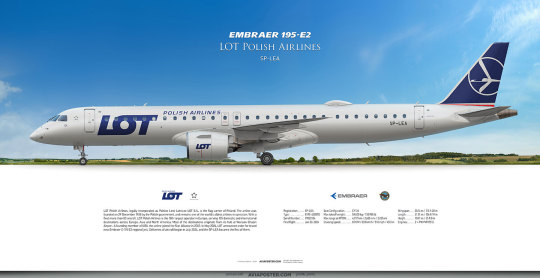
Embraer 195-E2 LOT Polish Airlines
Registration: SP-LEA Type: E190-400STD Engines: 2 × PW PW1921G Serial Number: 19020124 First flight: Jun 20, 2024
Starting with Fokker F.VIIs, LOT’s fleet has changed dynamically, reflecting the evolution of aviation technology and the shifting eras of Poland itself. Over its nearly century-long history, LOT has overhauled its fleet multiple times. In its first decades, the airline flew Douglas DC-2s, Lockheed Model 10A Electras, and later Model 14H Super Electras. Post-war, Soviet aircraft took the stage, with Il-14s, Il-18s, Tu-134s, Tu-154s, and the flagship Il-62. New times brought yet another fleet refresh, this time featuring Boeing, Bombardier, and, in the early 2000s, a newcomer – Embraer.
LOT first got acquainted with Brazilian planes in 2004 when it took on the Embraer 170. Back then, these “Brazilians” were fresh faces in aircraft manufacturing, and LOT decided to take a chance on them. Compact, fuel-efficient, perfect for regional routes – just the ticket. The 170s were followed by Embraer 175s and 195s, with LOT operating around fifty of these machines in total. They became the workhorses for routes like Warsaw-Krakow, Warsaw-Riga, or Warsaw-Amsterdam. Over the years, Embraer became a mainstay for LOT, and the airline even set up its own maintenance system for these planes. By the 2020s, though, some of the older Embraers had to be retired – time takes its toll. New models stepped in to take their place.
The Embraer 195-E2 is the latest chapter in LOT’s story. These planes, part of the E-Jets E2 family, started joining the fleet in 2024. The first one (SP-LEA) landed in Warsaw in July, with two more arriving by October. The E195-E2 is a different beast from its predecessors. Its Pratt & Whitney PW1000G engines save fuel and run quieter, while the wings, with their large winglets, cut down on drag. The cabin, though designed for 146 seats, was configured by LOT for 136 to give everyone a bit more room. They’re now flying from Warsaw to London, Istanbul, Amsterdam, and other cities. Passengers are pleased – the cabin’s quiet, and there’s more legroom in economy than in the older models. LOT didn’t choose these planes on a whim: they’re cheaper to maintain than big Boeings and ideal for 2-3 hour flights. Plus, they can land at smaller airports where larger jets can’t maneuver.
Poster for Aviators aviaposter.com
8 notes
·
View notes
Note
Could you possibly make N841AN? A 787-9 dreamliner operated by American Airlines? Just a thought and I LOVE your postures
Of course I can make N841AN for you. The cost of a new poster is 100 USD. If you want to order it, I will send you a payment link by email. Give me your email address
2 notes
·
View notes